|
Location:
Punjab, Indus River tributary, N.E. Pakistan. |
Grid Reference:
30.633 N, 72.867 E |
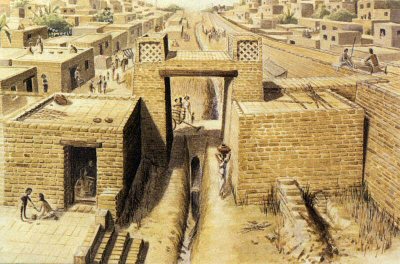
 Harrapa:
(Indus Valley City).
Harrapa:
(Indus Valley City).
The earliest levels
of Harappan culture are at 3,300 BC with the city being established
at c. 2,600 B.C.
The site contains the ruins of a
Bronze Age fortified city, which was part of the Indus Valley
Civilization, centred in Sindh and the Punjab.
(1)
The city is believed to have had as many as 23,500 residents at its
height.
(Map
of Harrapa)
(Map of Indus Valley)
The
Indus Valley Civilization (also known as Harappan culture) has
its earliest roots in cultures such as that of
Mehrgarh, approximately 6,000 BC. The two greatest cities,
Mohenjo-Daro and Harappa, emerged
Later c. 2,600 BC along the
Indus River valley in
Punjab and Sindh. (3) The
architecture and city planning of Harappa was similar to that of
Mohenjo-daro and the varieties of artifacts recovered from the
excavations confirmed that these two sites represented the same
cultural tradition which has come to be known as the Harappa
Phase of the Indus Valley Civilization.
(2)
They both planned the patterns of
their cities, laying out streets in rectangular patterns and
including drainage systems that led to brick-lined sewers. They
lived in brick buildings, some two and three stories high. In
almost every respect, they were an advanced people.
Chronology:
The
first extensive excavations at Harappa were started by Rai
Bahadur Daya Ram Sahni in 1920. His work and contemporaneous
excavations at Mohenjo-daro first brought to the world's
attention the existence of the forgotten Indus Valley
civilization as the earliest urban culture in the Indian
subcontinent.
The
Harappa site was first briefly excavated by Sir Alexander
Cunningham in 1872-73, two decades after brick robbers
carried off the visible remains of the city. He found an
Indus seal of unknown origin. His work was followed later in the
decade by that of Madho Sarup Vats, also of the
Archaeological Survery of India. M.S. Vats first excavated
the "Granary," and published the results of his and Sahni's
excavations in 1940. Excavations by other archaeologists
continued in the 1930's, and in 1946 Sir Mortimer Wheeler
excavated the so-called fortification walls and found the
first pre-Indus Valley civilization (Kot Dijian) deposits.
Article:
Nov, 2012 (GlobalPost.com):
'Archaeologists Confirm Indian Civillisation is 2000 Years Older
than Previously suspected'
'Indian
archaeologists now believe the ancient Indian civilisation
at Harrapa dates back as far as 7,500 BC. �When Bhirrana
[Rajasthan] was excavated, from 2003 to 2006, Recovered
artefacts provided 19 radiometric dates,� said Dikshit, who
was until recently joint director general of the
Archaeological Society of India. �Out of these 19 dates, six
dates are from the early levels, and the time bracket is
forming from 7500 BC to 6200 BC.�
(Link
to Full Article)
Excavations by
the Harappa Archaeological Research Project have been able to build
on these earlier studies to define at least five major periods of
development starting at c. 3,300 Bc and lasting until c. 1,300 BC
(2). They are
defined in the following fashion:
3,300 BC -
'Ravi' Phase-
The earliest
architectural structures at this time appear to have been huts
oriented north-south and east-west made of wooden posts with walls
of plastered reeds. Some mud-brick fragments of what may be a kiln
have been found, but no complete mud-brick architecture has been
found to date.
Pottery: The
potters wheel became used towards the end of this phase. The use of
pre-firing "potter's marks" and post-firing "graffiti" on pottery
also indicates that concepts of graphic expression using abstract
symbols were emerging. Many of the marks and signs
consisted of a single character or symbol, but one example has three
linked trident or plant shapes. Many of marks and signs used during
the Ravi Phase continued to be employed through the Kot Diji Phase,
and on into the Harappa Phase, where some of them can be identified
as elements of the Indus writing system.
2,800 BC - 'Kot
Diji' Phase -
The wide variety
of raw materials used in specialized crafts during the Kot Diji
Phase indicates the continued expansion of trade networks that were
initiated during the Ravi Phase. Marine shells were brought from
more than 860 kilometers away for ornament manufacture. Various
rocks and minerals were imported over distances of 300 to 1000
kilometers for the production of utilitarian objects such as
grinding stones and chipped stone tools as well for the manufacture
of ornaments such as beads and inlay
Of particular importance at this
time is the first appearance of the Early Indus script that has been
found on pottery, a sealing of a square seal with possible Early
Indus script, and a cubical limestone weight that conforms to the
later Harappan weight category. In 2000 a fragment of an unfinished
square steatite seal carved with an elephant motif was discovered
which indicates that this unique type of seal was being made in
addition to the more common geometric button seals (Meadow, Kenoyer and Wright 2000). These discoveries suggest that
the development of the Indus script, the use of inscribed seals and
the standardization of weights occurred during the Kot Diji period,
some 200 years earlier than previously thought. The emergence of
writing, seals and standardized weights also implies the development
of more complex social and political organizations that would have
required these sophisticated tools and techniques of communication
and administration.
(Full
List of Indus Valley Symbols)
2,600 BC 'Harrapan'
Phase -
The overall size
of the city at this time was over 150 hectares.
This phase is
marked by the greatest variation and widespread use of such seals
appears to be during Period 3B. Small rectangular inscribed tablets
made from steatite begin to appear at the beginning of Period 3B and
by the end of 3B there is a wide variety of tiny tablets in many
different shapes and materials. They were made of fired steatite or
of moulded terracotta or faience. Some of the steatite tablets were
decorated with red pigment and the faience tablets were covered with
a thick blue-green glaze.
The
Harappans used the same size bricks and standardized weights
as were used in other Indus cities hundreds of kilometres
away, such as
Mohenjo Daro .
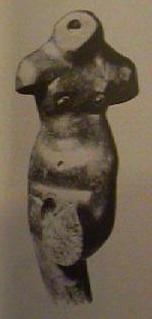

Both male and female torso's were carved, c.2000 BC. Red sandstone, 3
3/4" high (Right).
The ancient Indus systems of sewerage and drainage that were developed and
used in cities throughout the Indus region were far more advanced than
any found in contemporary urban sites in the Middle East and even more
efficient than those in many areas of Pakistan and India today. The
advanced architecture of the Harappans is shown by their impressive
dockyards, granaries, warehouses, brick platforms, and protective walls.
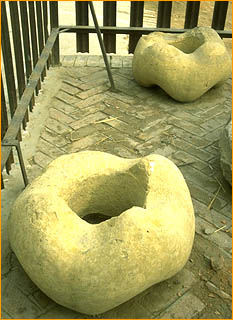
These giant ring-stones are similar to ones found in
Mohenjo-daro and Dholavira. Local legend claims they were the rings of a
giant 17th century saint (Baba Nur Shah) who is buried on Mound AB.
Early excavators believed that were significant to the ancient Indus
religion. Today, archaeologists think that they were used to secure
wooden posts at gateways to the city.
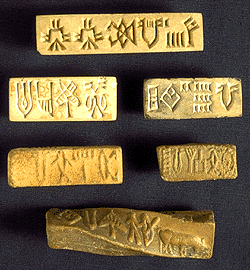
Several gold
Bars with inscriptions on were discovered at Harrapa.
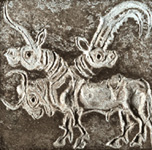
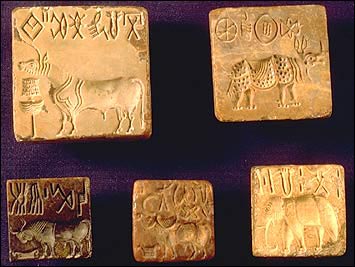

Some Examples of the numerous seals
discovered at Harrapa.
These various
forms of inscribed tablets continued on into Period 3C where we
also find evidence for copper tablets all bearing the same
raised inscription. The copper tablets at Mohenjo-daro are
incised and have several variations in terms of animal motifs on
one side and inscriptions on the opposite side.
(Mohenjo Daro)
(Indus Valley
Civilisation)
(Prehistoric India)
|